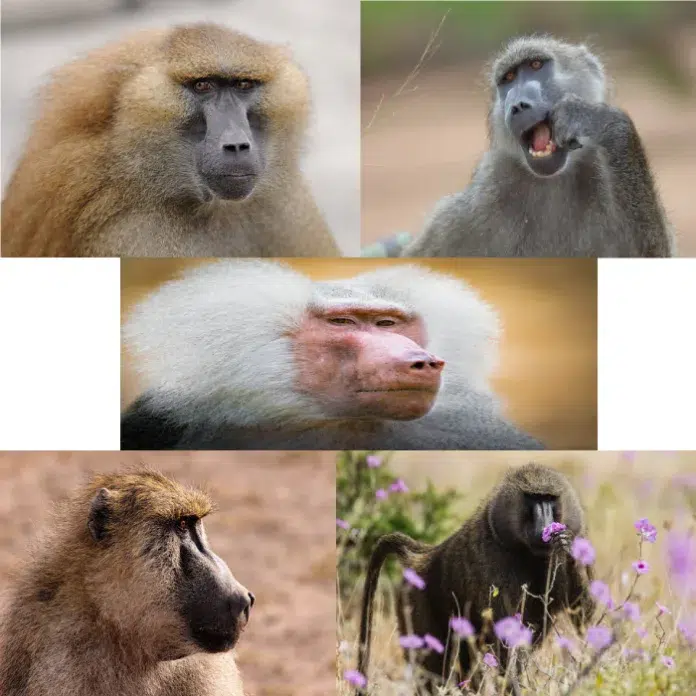Table of Contents
Scientific Classification
| Kingdom | Animalia |
| Phylum | Chordata |
| Class | Mammalia |
| Order | Primates |
| Family | Cercopithecidae |
| Genus | Papio |
| Species | Varies by type |
| Scientific Name | Papio spp. |
There are five recognized species of baboons:
- Papio anubis (Olive Baboon)
- Papio cynocephalus (Yellow Baboon)
- Papio ursinus (Chacma Baboon)
- Papio papio (Guinea Baboon)
- Papio hamadryas (Hamadryas Baboon)
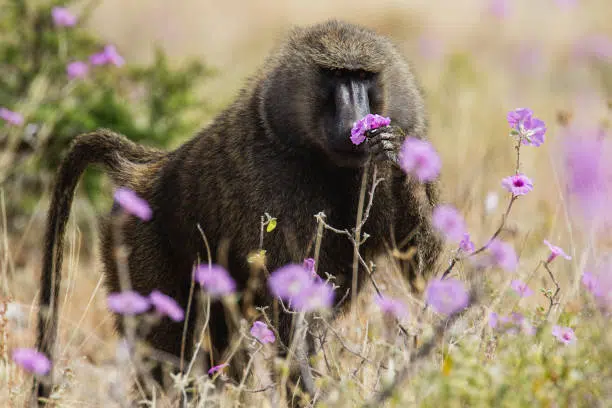
Papio anubis (Olive Baboon)
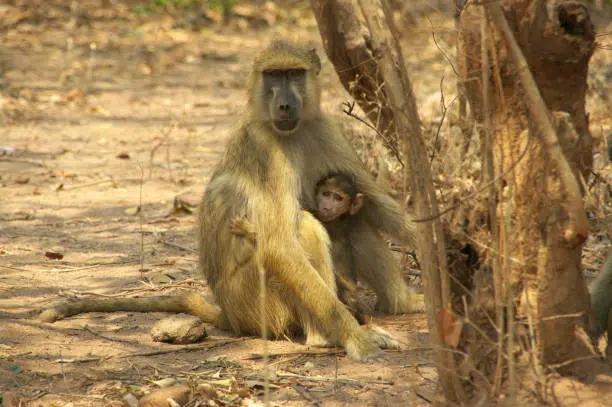
Papio cynocephalus (Yellow Baboon)
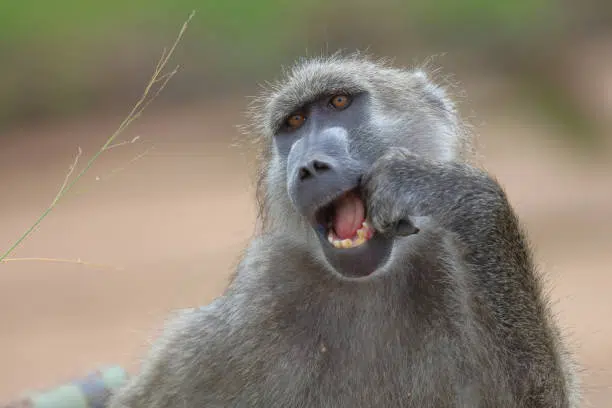
Papio ursinus (Chacma Baboon)
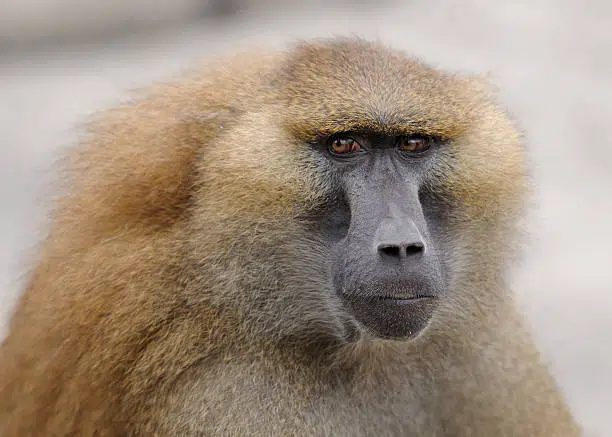
Papio papio (Guinea Baboon)

Papio hamadryas (Hamadryas Baboon)
Description
Baboons are hard to miss. With their expressive eyes, strong limbs, and distinctive dog-like muzzles, they stand out as one of the most fascinating Old World monkeys. There’s just something about them—robust, intelligent, and bursting with personality.
Depending on the species, baboons can sport a range of colors, from yellow and olive to deep gray or silver. Males are significantly larger than females, with some tipping the scales at up to 90 pounds (40 kg) and standing nearly 3 feet tall on all fours. One of their most striking features is the large canine teeth found in males. While they might look intimidating, these teeth primarily serve as tools for showing dominance.
Their hindquarters are adorned with noticeable and often colorful ischial callosities—thickened patches of skin that allow them to sit comfortably for extended periods. Female baboons also develop prominent sexual swellings when they’re in estrus, signaling their fertility.
Beneath their tough exterior, baboons are emotionally expressive and socially savvy animals. They live in structured groups where relationships can influence feeding rights and protection.
Distribution
Baboons can be found across Africa and in certain parts of the Arabian Peninsula, with each species having its own distinct territory.
Olive Baboons are quite common throughout equatorial Africa.
Yellow Baboons make their home in the eastern and southern regions of Africa.
Chacma Baboons are located in southern Africa, particularly in South Africa and Namibia.
Guinea Baboons are limited to a smaller area in West Africa.
Hamadryas Baboons are quite special; they’re the only species that spans continents, living in northeastern Africa as well as parts of Yemen and Saudi Arabia.
These fascinating monkeys rank as the second most widespread primates on the planet, right after humans.
Habitat
Baboons are truly the masters of adaptation. You can spot them in a variety of habitats, from dry savannas and scrublands to lush forests, rocky hills, and even semi-deserts. One thing they can’t live without, though, is access to water and some sort of high ground, like trees or cliffs, which offer them a safe place to rest.
When night falls, baboons make their way up tall trees or steep cliffs to steer clear of predators. By day, they roam and search for food in groups, often trekking several miles in their quest for a meal.
Their remarkable adaptability is what allows baboons to flourish in environments where other primates might struggle.
Diet
Baboons are fascinating omnivores with a surprisingly diverse diet. They munch on a variety of foods, including:
– Fruits and seeds
– Leaves, grasses, and roots
– Insects, spiders, and scorpions
– Birds’ eggs and nestlings
– Small mammals, and occasionally, young antelope
Their knack for eating just about anything helps them thrive even in tough environments. Baboons often raid human farms, snatching up crops like corn, sweet potatoes, and bananas, which can lead to some pretty tense encounters with people.
These clever foragers are quite resourceful. They can use tools, crack open nuts, and even follow larger animals like elephants to discover new food sources.
Behavior
Baboons form social groups known as troops. These troops can have just a few members or more than a hundred. Within these troops, hierarchy is everything. Males often battle for dominance. Females inherit their rank from their mothers. This creates strong matrilines.
Social grooming is a cornerstone of baboon life. It strengthens bonds, reduces tension, and communicates trust. A baboon troop is like a drama that never stops. Alliances form and break. Disputes pop up and get resolved. Meanwhile, young baboons play while adults keep a watchful eye.
Though primarily terrestrial, baboons are excellent climbers. They walk on all fours and use their strong arms and keen eyes to scale trees or rocky outcrops when necessary.
Communication in baboons is incredibly rich. They bark alarm calls and grunt. They also scream and use facial expressions. Their body postures help show messages, like threats or affection.
Lifespan
In the wild, baboons typically live around 20 to 30 years, depending on the species and local threats. In captivity, they often live longer. They can reach ages of 40 to 45 years thanks to veterinary care and regular food supplies.
Lifespan is influenced by multiple factors:
- Troop dynamics (dominant animals live safer lives)
- Access to food and water
- Predation
- Disease and injury
Female baboons often live longer than males, especially in high-conflict troops.
Reproduction and Lifecycle
Baboons have a pretty interesting approach to relationships—they’re polygynandrous, which means both males and females can have multiple partners. When a female is in estrus, her swelling is a clear signal that she’s ready to mate. Males have their own ways of courting; they might groom the females, protect them from other males, or simply stick close during the fertile period.
After about six months of gestation, a single infant is born, and this little one is completely dependent on its mother. It clings to her fur and nurses frequently.
Infants are cherished members of the troop, drawing attention from mothers, older siblings, and even unrelated females, who are affectionately referred to as “aunts.”
By the time they reach three to six months, the young ones start to venture out on their own. Females typically reach sexual maturity between 4 to 6 years, while males mature a bit later, around 5 to 8 years. Once they grow up, males usually leave their birth troop, but females tend to stay close to their mothers.
Predators
Though powerful and vigilant, baboons still face threats in the wild. Their main predators include:
- Leopards – perhaps their most effective natural enemy.
- Lions – capable of ambushing baboons at night or near water.
- Crocodiles – often strike when baboons drink or cross rivers.
- Hyenas and jackals – may prey on young or sick individuals.
- Humans – the most dangerous of all, due to habitat destruction and hunting.
Baboons counter threats by posting sentinels when they rest. They also travel in tight groups and use coordinated alarm calls to warn others.
Adaptations
Baboons have evolved a suite of physical and behavioral traits to help them survive:
- Powerful limbs for walking long distances and climbing.
- Large canines for defense and dominance displays.
- Excellent vision, including color vision, to detect food and danger.
- Complex social intelligence—a necessity for navigating troop politics.
- Flexible diet, allowing survival in a range of habitats.
Their thick skin pads, called ischial callosities, help them sit comfortably on rough ground. This makes it easier for them to feed or groom.
Nest
When it comes to sleeping arrangements, baboons are quite different from tree-dwelling primates that build nests. Instead of crafting their own cozy spots, baboons prefer to find natural shelters like cliffs, caves, and tall trees to keep safe during the night.
These clever creatures are picky about where they sleep. Often, they return to the same spot for weeks or even months at a time. Choosing high places gives them a great view to spot any lurking predators, while steep cliffs offer quick escape routes if needed.
At night, young baboons snuggle up with their mothers, and this close bonding time is essential for strengthening their social ties.
Mating Season
Baboons don’t stick to a specific breeding season, especially in tropical regions where food is plentiful year-round. In places with distinct seasons, mating often peaks during the rainy season, which helps ensure that births coincide with times of plenty.
When it comes to mating, baboons form both casual and long-term connections:
Consortships happen when a male and female create a temporary, exclusive bond.
Higher-ranking males might have more opportunities to mate, but clever or lower-ranking males can still forge friendships with females, giving them a chance to mate as well.
The courtship process is quite subtle—grooming, close physical contact, and gentle vocalizations usually come before mating.
Breeding
A healthy female baboon gives birth every 1.5 to 2 years, depending on her social status, nutrition, and age. Infant mortality is high in the wild. This is mainly due to disease, predation, and troop conflict.
Mothers are intensely protective. In many species, infants start by riding on the mother’s stomach. As they get stronger, they move to her back.
In species like the Hamadryas baboon, males create harems. They protect and mate only with a group of females. In others, like the olive baboon, females choose their mates more freely.
Most parental investment comes from mothers. However, fathers may protect the young if they believe they are the father or have a close bond with the mother.
Interesting Facts
- In Ancient Egypt, people respected Hamadryas baboons. They linked these animals to Thoth, the god of wisdom.
- Troop Size Varies: Some troops can have more than 100 members when food is plentiful.
- Tool Users: Baboons have been observed using sticks to dig or as weapons.
- Human-Like Behavior: They make friends, form alliances, and sometimes betray, just like us.
- Baboons show fear, aggression, joy, and submission. They use facial expressions and vocal sounds to communicate these feelings.
- Highway Raiders: In South Africa, Chacma baboons frequently snatch food from cars and picnic baskets.
Conservation Status
Baboons are not currently considered endangered, but that doesn’t mean they’re safe. According to the IUCN:
- Olive and Yellow Baboons are classified as Least Concern.
- Chacma and Hamadryas Baboons are Near Threatened in some areas due to habitat loss.
- Guinea Baboons are considered Near Threatened.
Threats include:
- Deforestation
- Agricultural expansion
- Conflict with humans
- Illegal pet trade and hunting
Conservation efforts focus on habitat protection, reducing human-wildlife conflict, and public education. In some areas, baboons support eco-tourism. This helps fund conservation and raise awareness.
Conclusion
Baboons are more than just monkeys with a bit of an attitude; they’re incredibly intelligent and emotionally rich beings. They mirror many aspects of human society. Their ability to bounce back from challenges and adapt, along with their vibrant social interactions, makes them some of the most intriguing creatures on our planet.
However, their future depends on how effectively we safeguard their habitats and learn to live alongside them. Watching these clever animals forage in the savanna or nurture their young reminds us that we share more similarities than we might think.
If you ever come across a troop of baboons in the wild, take a moment to observe. Listen to their chatter and watch their movements. Pay attention to their bonds, rituals, and the expressions in their eyes. You’re witnessing one of nature’s most intricate social systems at work.


